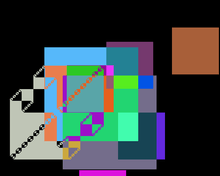Display hack

A display hack is a computer program with similar purpose to a kaleidoscope: to make pretty pictures (symmetrical or otherwise). Famous display hacks include munching squares and smoking clover. Some display hacks can be also implemented by creating text files which contain numerous escape sequences for a text terminal to interpret. A famous example on the VT100 terminal displayed a Christmas tree, with twinkling lights and a toy train circling its base. The XScreenSaver software contains a large collection of X Window System and OpenGL display hacks.
Display hacks have a history of several decades. Arguably the first display hack was a program called Bouncing Ball on the Whirlwind computer in the early 1950s. The famous munching squares hack, on the other hand, originates in the PDP-1 computer in ca. 1962.
Crack intros, display hacks programmed by software crackers for the home computers of the 1980s, evolved into what was to be known as demos and demo effects. The creation of demos later became a subculture of its own, now known as the demoscene.
See also
- Demoscene, a related subculture
- Computer-generated imagery
- Cellular automata
- Fractal art
External links
- The Origin of SpaceWar, an article by J. M. Graetz originally published in the August, 1981 issue of Creative Computing magazine, mentions some early display hacks.